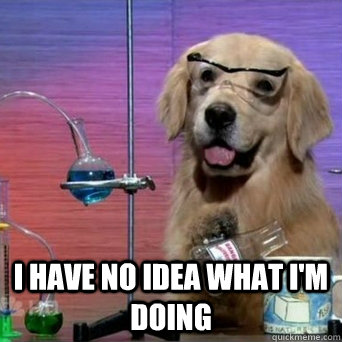If there’s one thing 20.109 teaches best, it’s that there’s
no such thing as teaching someone the “right” way.
 |
| The existence of a wrong way depends on the person |
Sure, it could be a yes or no question, there could be a rubric,
or a step by step protocol, but at the end of the day, there’s a “well maybe,”
or a way to think outside the rubric, or a mistake in the protocol, or a way to
do it differently. These alternatives don’t necessarily make the result better,
and often what works in one situation doesn’t in another, but they prove that
there is no “right” or best way. If I sit here and try to compare the
similarities and differences between the three modules, I feel like I’m stuck trying
to compare… well… that’s the problem. What we learned was basically variations
of how to do the same thing – science. But from assignment to assignment, it
was never the same. There is no actual formula.
 |
| Oh look I made one |
Being given a protocol and a way to communicate science are
basically the same concept – here’s something that has worked well for others,
which doesn’t necessarily mean it’s the best way, but without the guidance of
those who have come before you, you’re probably just going to end up staring at
a plate of cells or Eppendorf tube telling yourself “I have no clue what I’m
doing” over and over and over again.
 |
| Me 80% of the time |
What we learn in 20.109 is that no matter how closely you
follow what you’re told to do, there’s no guarantee that it’ll work how it should.
And if you screw up, there’s a chance it will work fine. Unless you burn the
lab down. But then again I suppose it depends on what you’re trying to
accomplish. There’s a time and place for everything.
 |
| Putting my figure-making skills to good use |
You’d think that would put you down, like, why would you
keep trying if no matter how much you try things could go wrong at any moment?
But in truth, it’s almost a relief, although I suppose your outlook depends on
what type of person you are. Professor Leona Samson put this very well during
one of her lectures: “Experimental science selects for optimists.” If things
were black and white, optimism and pessimism wouldn’t exist, and can you
imagine how dull life would be? Let’s look at a few examples of optimism and
pessimism.
And this might be what makes science so awesome. Not just
the fact that we’re constantly learning and answering questions, satiating our
inner curious child, but the fact that we’re surrounded by other like-minded
individuals, rebounding from every setback and constantly finding the bright
side. It might be the science that draws us in, but at the end of the day, it’s
the people who keep us going. Although there’s (arguably) no true black and
white, right or wrong, good or bad, there’s something that keeps us coming back.
We scientists, or more accurately, excitable little bundles of questions and
thoughts, have made a home for ourselves in the gray, and each day we look into
the unknown and smile with the knowledge that there’s always another answer,
another speculation.
 |
| And slowly, like Pokemon, we evolve and grow |

No comments:
Post a Comment